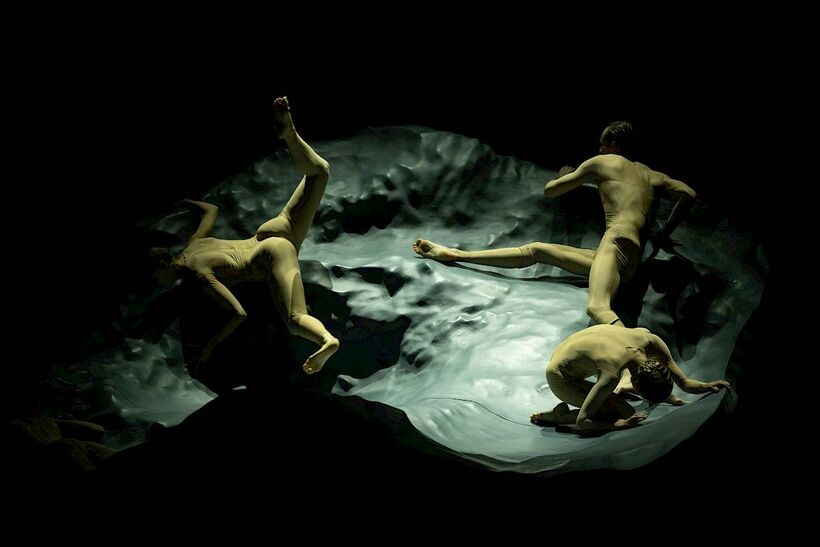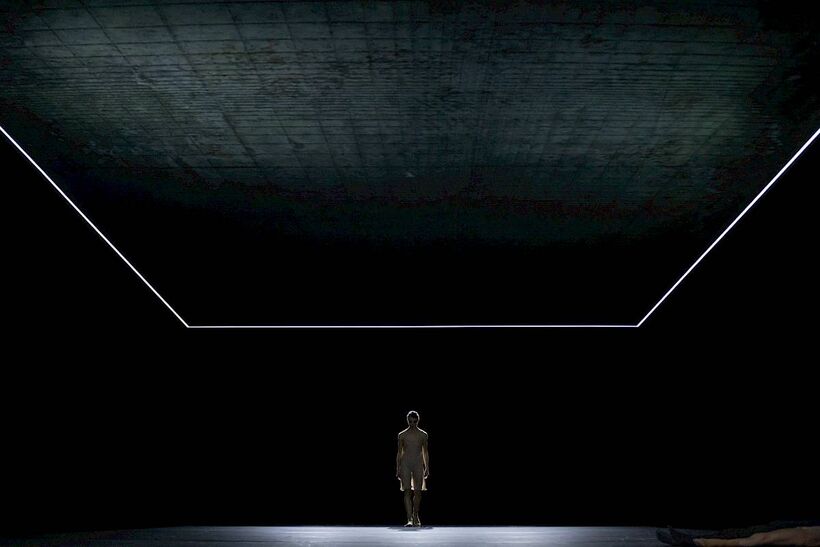On the move – Christian Spuck’s Goodbye to Zürich in Three Parts
The long-serving artistic director of Ballet Zürich, Christian Spuck, is moving to the Berlin State Ballet next season. This winter, Zürich theatregoers join Spuck’s dancers and the Philharmonia Zürich for a grand farewell. Czech Dance News paid the glamorous Opernhaus a visit to get a sense of what Zürich has to offer and what Berlin can look forward to.
Ballet Zürich is regarded among Europe’s finest ballet companies, and their collaboration with the equally accomplished Zurich Philharmonia promises a feast for both the ears and eyes. The three-part evening On the Move turned out to be fully emblematic of the qualities of both dancers and musicians. Judging from this performance, there is no doubt that new director Cathy Martson will be taking over an institution in rude health.
A Dutch Master
For the first part (and headliner) of his farewell-triptych, Christian Spuck had chosen acclaimed Dutch choreographer Hans van Manen’s piece, On the move. Set to Sergei Prokofiev’s 1st violin concerto, On the move was originally made for Netherlands Dance Theatre in 1992. Ballet Zürich’s performance was both an homage to a brilliant artist and a demonstration of the very pinnacle of our art. Hans van Manen turned 90 last year, but still he came to Zürich before the premiere to approve Spuck’s adaptation. Approve he did, and we agree wholeheartedly with the old master. At the Opernhaus, the piece proved its timelessness: a reminder of what we all strive for, and of why we all fell in love with dance in the first place.
There was so much life and emotion in this utterly abstract and geometrical piece. No wonder Hans van Manen is considered the “Mondrian of dance”. While without an explicit narrative, the visual sensuality and musicality of the performance kept us on the edge of our seats. The various pairs engaged and disengaged following the dramatic ebb-and-flow of Prokofiev’s score, forcefully interpreted by solo violinist Bartlomiej Niziol. Often, the whole group would enter the stage with a sombre and dark musical accompaniment, anticipating something, a change in the horizon.
The intimate glances between the dancers in the pas de deux were emblematic of the tension between classicism and modernism, between the formal austerity and the sexual energy that permeated the piece. It was mathematically rigid in its structure, stern and precise in the movement-vocabulary, but flowing so naturally that every new section seemed the only possible outcome, and every new theme of the score seemed to be necessitated by the dynamic of the dancers. Everything remained ‘on the move’, culminating with all dancers on stage and the female lead – interpreted by the excellent and charismatic Irmina Kopaczynska – turning away from her partner – the equally impressive Daniel Mulligan – leaving dancers and audience behind. With a calm air of reconciliation, she seemed to be leaving both the stage and our earthly struggles for a higher dimension.
Hans van Manen’s On the move is a short piece, but it left the audience breathless.
A Promising Debut
Hans van Manen was certainly a hard act to follow. But it must be said, with Tal (Valley), young choreographer Louis Stiens passed with flying colours. On a dark stage, androgyne bodies in brown, skin-tight costumes danced with convulsions and movements of violent conflict. It was an organic and earthbound dance, contrasting starkly with the sensual precision of the prior piece.
His young age notwithstanding, this was without question the most challenging and imaginative piece of the evening, combining material rawness in the tradition of Pina Bausch and post-human enactment in the vein of Dimitris Papaioannou. Tal started with the lonely, dark figure of Jan Casier standing on a huge rock-like mass. The dancer stared into the far-away landscapes, in a pose alluding to the romantic figure of the Wanderer above the Sea of Fog by Caspar David Friedrich. The invisible interaction and hidden conflict between human and nature remained the dominant idea throughout the piece.
Moving from Prokofiev’s fast-paced and upbeat violins, we were then served a selection of contemplative impressionist pieces by Claude Debussy (Nocturnes) and Maurice Ravel (Gaspard de la Nuit, Miroirs). In the background, we heard sounds recorded from Mount Uetliberg. In Stien’s piece, these “real” sounds of present-day Anthropocene nature placed the impressionists’ naive submission to the sensation of the Other in a very different light.
The large black rock – created by designer Bettina Katja Lange – rotated around the stage with the dancers sliding up and down, letting their bodies adapt to the shapes of the rough surface. At one point, one of the dancers almost lost his footing. These are the perils of Steins’ ‘modern nature’: distanced from our basic human instincts, nature becomes unnatural. When they were not clinging to the rock face like sludges after rainfall, the creatures danced on their own in front of it. Abandoned to a dark, empty stage, left without features or recognisably human movements, clinging to an artificial 3D-printed rock, modern man’s connection to life seemed depressingly precarious.
Louis Stiens has created something distinct and thought-provoking. But in light of van Manen’s mastery, he had the air of an apprentice. The narrative development proved to be slightly unfinished. The third (or was it fourth... or even fifth?) time the bodies recommenced their curious sludging, it became a déjà vu (but not in the uncanny Freudian sense) moment. That said, the final image was remarkable in its simplicity: a lone body crouched in despair at the foot of the black rock as the lights faded and the curtain dropped. A fittingly dystopian parting message to a thought-provoking yet unfinished piece.
A Cold Farewell
After the presentation of two diverse pieces, it was time for Spuck’s final goodbye to the stage where he had reigned supreme for the last decade. Unfortunately, after Hans van Manen’s grand opening and Louis Stiens’ fresh imagination, Lontano fell well short. In the program notes, Spuck describes Lontano as a “farewell postcard”. But just like postcards from souvenir-shops need a written greeting before sending, Spuck’s farewell needed to add a personal message to the collage of dance moves. The technical mastery of the company’s thirty dancers could not hide the lack of any real content.
Starting with Kol Nidre by John Zorn, the piece alluded to a ritual of purification, or even liberation. Further on, György Ligeti’s creeping music created a claustrophobic atmosphere, assisted by the slow lowering of a neon rectangle above the dancers’ heads. Slow, imperceptibly evolving harmonies reverberated from the orchestra, filling the room with a strange suspense. The dancers on stage, however, seemed to be interpreting a whole different score, performing their moves rapidly and monotonously, with a solipsistic air of oblivious concentration.
A dance so dissociated from its music, and so seemingly without a cause, makes for a tough watch. It was evident from the squeaking of seats and the ever more frequent coughs emanating from around the Opernhaus hall that the spell of this wonderful evening was broken long before the music receded. The performance finished with Frederick Chopin’s Prelude op. 28 (performed by Alice Sara Ott). The effect was confusing. While the music transmitted immense melancholy and sadness, even here, the dance remained detached. The music stopped, but the dancers continued their movements, leaving us wondering whether they had ever been listening at all.
Written from the performance of the 21 January 2023 at Zürich Opernhaus, Zürich.
On the move
Choreography: Hans van Manen
Costumes: Keso Dekker
Lighting designer: Joop Caboort
Music direction: Alevtina Ioffe
Music: Sergej Prokofjev
Choreographic producer: Ken Ossola
Violin solo: Bartlomiej Niziol
Tal
Choreography: Louis Stiens
Stage design: Bettina Katja Lange
Costumes: Louis Stiens
Sound collages: Michael Utz
Lighting designer: Martin Gebhardt
Music direction: Alevtina Ioffe
Music: Claude Debussy, Maurice Ravel
Dramaturgy: Michael Küster
Assistant choreographer: Shaked Heller
Lontano
Choreography: Christian Spuck
Stage design: Rufus Didwidzus
Costumes: Emma Ryott
Lighting designer: Martin Gebhardt
Music direction: Alevtina Ioffe
Music: György Ligeti, John Zorn, Frédéric Chopin
Dramaturgy: Michael Küster





